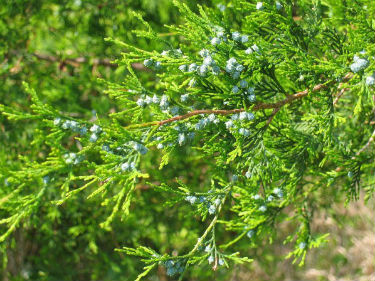 Juniper, or Atlantic white cedar, was once a dominant tree in the swamp forests of the coast. |
Interested in planting an increasingly rare coastal tree on your property? Have we got a deal for you.
The N.C. Coastal Federation and the U.S. Fish and Wildlife Service have gotten together on a program that will pay landowners 80 percent of the cost of planting Atlantic white cedar, or juniper.
Supporter Spotlight
Atlantic white cedar, Chamaecyparis thyoides, was once a well-established ecosystem on the Albemarle-Pamlico peninsula of North Carolina. Then, more than 500,000 acres of juniper covered the Eastern seaboard. Less than 5 percent of that acreage remains.
A Current Rarity
What happened to all of it? A combination of things did the cedar in. Much of the peat lands along the Alligator River and in the Great Dismal Swamp, where much of the cedar forests grew, were ditched and drained for farming in the late 1700s. That made the land unsuitable for cedar, which requires waterlogged soils rich in peat, which is made up of partially decayed plant material.
The other factor is that Atlantic white cedar is fantastically useful wood. It’s fragrant, strong and rot resistant—perfect for boat building, shingles, decoys and many other useful items. The forests that remained after the draining were hit hard, and acreage continued to dwindle.
“Atlantic white cedar, what’s that? Our boats are made of juniper,” deadpans Captain Ernie Foster.
Foster is the owner of the Albatross Fleet, three striking charter fishing boats on Hatteras Island that were all originally made of white cedar. “My father got the wood for the original Albatross in 1935, from Buffalo City, near East Lake,” Foster remembers. “Everyone used to use juniper to build boats. It’s strong, light and damn near impervious to rot below the water line if you coat the end-grain.
Supporter Spotlight
 The boats in the famous Albatross Fleet of Hatteras are made of juniper. |
“Besides,” he adds. “I love how it smells.”
This brings to mind another use: “hope chest,” another traditional use that had prospective brides placing linens and other household necessities in the chests so they would become imbued with the wood’s scent. Woodworkers also report that they were great at keeping moths out of wool clothing. Furniture factories in High Point and private craftsman made these chests up until the 1950s, when their popularity began to wane.
That very popularity, however, posed many problems for the landscape and the creatures that depend on cedar for habitat and the water quality benefits it brings.
“A stand of juniper, as it’s referred to by most people in coastal N.C., is a unique and valuable habitat, especially for migratory songbirds,” said Kendall Smith, private lands biologist with the U.S. Fish and Wildlife Service in Columbia, S.C. “Even in mixed stands, it’s an important component that is missing in many of our wetland forests.”
In North Carolina, cedar swamp nesters include prairie, prothonotary and hooded warblers; ovenbirds; and yellow-throats. Cedar swamp ecosystems support a higher density of nesting birds than maple-gum forests, nearly twice as high. Cedar swamps are also prime habitat for endangered swamp pinks, fringed orchids, turkey-beard and curly-grass fern, among others.
Stands of cedar also help prevent erosion and improve water quality by providing filtration, preventing nutrient and water clarity problems that plague oysters and other coastal animals, a prime concern of the federation’s.
The Deal
Learn More To find out more about the project or to schedule a site visit, contact Kendall Smith of the U.S. Fish and Wildlife Service 252-796-2401 or email him. You can also call Christine Miller or Ladd Bayliss at the N.C. Coastal Federation at 252-393-8185. You can also email Miller and Bayliss. |
The federation and the Fish and Wildlife Service found that they had dovetailing goals, so they formed a partnership. Using service money, they are looking for private landowners with appropriate soils who want to plant juniper AWC their property. They’re looking to plant 50 acres for this phase of the project.
If you have the right kind of site, the federation and service will pay 80 percent of the cost to plant the trees and perform the maintenance needed to establish them. The landowner’s share could be in-kind services to plant and maintain the stand.
The 50 acres don’t need to be on one plot of land. While they prefer larger tracts, the partners will consider smaller parcels.
Project sites must be wetlands or former wetlands capable of being restored. They must also have supported juniper in the past. If prospective landowners contact the federation or the Fish and Wildlife Service, we can use soil types, fertility, and existing vegetation to make this determination. The federation would work with the landowner and service staff to develop a project plan, and the state Forest Service will provide the trees.







